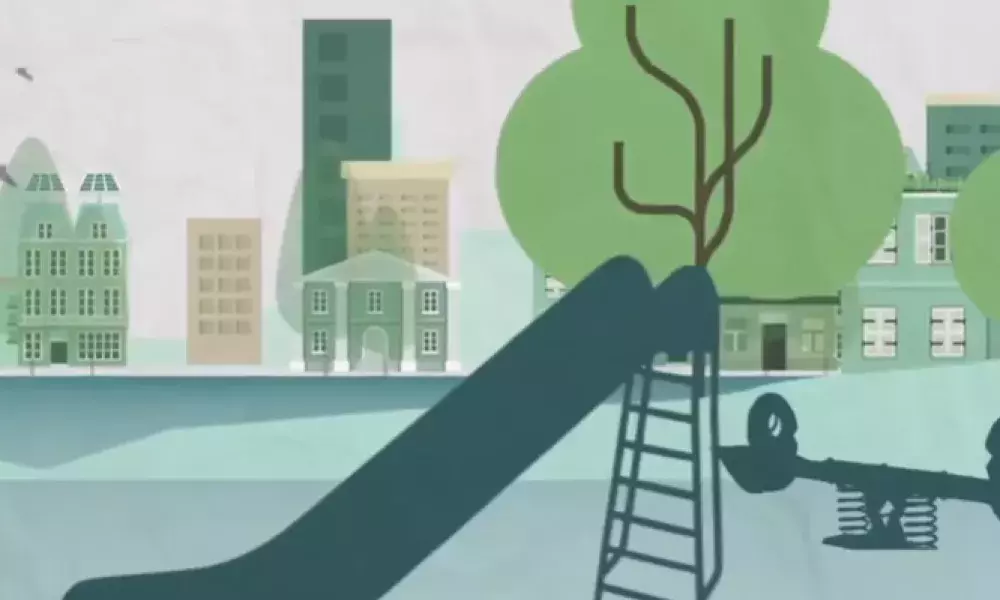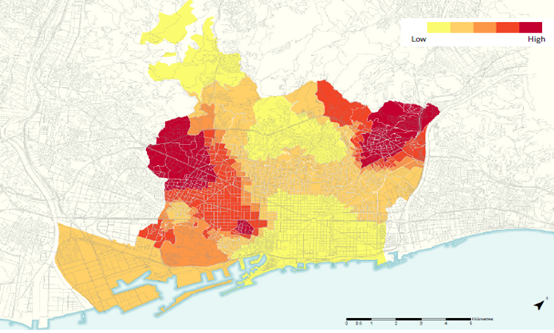Adapting Barcelona to Climate Change: A multi-criteria approach for the selection of schools to be converted to Climate Shelters - Zoom In

It should be mentioned that the justified selection of schools to be converted to Climate Shelters influences substantially the success of the project as far as the protection of the citizens during periods of high temperatures or at the occurrence of heat waves.
The Climate Shelters project in brief
Barcelona’s innovative pilot project [1] aims to develop a network of Climate Shelters [2] around the city by adapting schools to Climate Change. In practice, climate shelters are areas within the schools (practically their school yards) which by hosting blue, green and grey technical measures support the adaptation of the city to climate change. At the same time, the exposure of the school population to urban heat is ameliorated, whereas the possibility for the continuous use of the climate shelters by the wider public in non-school periods and throughout the year, is provided.
A novel dimension of the Barcelona project regarding the selection of the schools to be converted to Climate Shelters, is that it takes note of the urban (land cover), environmental (temperature, air pollution, greenery) and climatic (heat wave vulnerability) conditions in the city of Barcelona, as well as their spatial variations.
From an urban perspective, the above conditions are also linked to land cover, which for the case of the City of Barcelona is depicted in Figure 1 [3] for the year 2018. An examination of Figure 1 shows that a major part of Barcelona falls in the class “Continuous urban fabric Sealing Layer SL>80%”. This class is assigned when urban structures and transport networks are dominating the surface area. In addition, more than 80% of the land surface is covered by impermeable features like buildings, roads and artificially surfaced areas. Non-linear areas of vegetation and bare soil are exceptional. Furthermore, this class includes residential buildings, public service and commercial/industrial buildings with their connected areas with their size being less than 25 ha, parking lots, concrete or asphalt surfaces, small squares, pedestrian zones, yards and urban greenery (parks and grass areas) of size less than 25 ha and accounting to maximum 20% of the polygon area.
The extended coverage of the city with impermeable materials results in high values of land surface and air temperatures, the latter due sensible heat transfer from the ground to the air above. Areas like these are more vulnerable during summer months and particularly in the event of heat waves.

Figure 1. Land cover map of the City of Barcelona for the year 2018 (dark red refers to areas with continuous urban fabric Sealing Layer>80%, whereas purple refers to industrial, commercial, public, military and private units).
Land cover needs to be correlated to the spatial distribution of temperature so as to recognize the impact of urban form and functions to the state of the thermal environment, especially in the event of heat waves. Figure 2 presents the spatial distribution of temperature in Barcelona during the heat wave of 2015 [4].
Further analysis is considered necessary so as to assess the city’s vulnerability to high temperatures [4] in conjunction with such risk parameters as: population over 75 years old, energy insulation of buildings and amount of greenery in the city. vegetation. A respective map is presented in Figure 3.

Figure 2. Spatial distribution of air temperature during the heat wave of 2015. Areas with higher temperatures are associated with lower % of urban green.

Figure 3. Spatial vulnerability to high temperatures associated to heat waves.
To further explore the state of the urban environment, it is important to record the levels of photochemical air pollutants and correlate them to air temperature. Figure 4 provides the exposure levels of the population to the average annual concentration of NO2 for the year 2019 [5].

Figure 4. Exposure levels of the population to the average annual concentration of NO2 for the year 2019. Areas in orange and red exceed the EU limit value/WHO guideline of 40 μg/m3 (orange from 40-50 and red from 50-60 μg/m3).
Finally, urban greenery - especially street level trees -is beneficial for cooling (through evapotranspiration) and for shading. Figure 5 refers to Copernicus street layers trees product for Barcelona [6].

Figure 5. Street layer trees in Barcelona (2018).
The selection process is based on a set of criteria as divided into mandatory and priority ones, whereas an additional criterion was used for the selection of schools within the same district in the event of equal scoring. Table 1 provides the mandatory criteria for the selection of the schools [7].
Table 1. List of mandatory criteria for the selection of schools.

In terms of the priority criteria, they fall under four (4) distinct categories: Impact, Environment, Buildings and School yard [7].
A. Impact. Criteria that assess the degree of impact to the beneficiaries.
A.1 Number of lines (equivalent to the number of classes at the same students' level per school)
A.2 Shared use of the school yard with other uses.
A.3 Adjacent buildings / courtyards with other schools (nursery, high school, etc)
In order to maximize the impact of beneficiaries, schools that (a) have two or more lines (b) have summer camps at their own facilities and (c) share either the playground or the building with a nursery or high school, receive higher scores.
B. Environment. Criteria that evaluate the environmental conditions of the school’s environment.
B.1 Prioritization of schools located in areas of Barcelona of higher vulnerability to climate change.
B.2 Prioritization of schools located in areas with higher air pollution.
B.3 Prioritization of schools located in areas with lower greenery.
C. Buildings. Criteria that evaluate the conditions of the building in terms of exposure to heat, thermal insulation and energy efficiency.
C.1 Number of classrooms exposed to direct sunlight. Prioritization of schools with respect to their orientation towards the horizon so as to define buildings and schoolyards which are exposed more to solar radiation and heat.
C.2 Number of classrooms under building roofs exposed to solar radiation.
C.3 Energy efficiency especially with respect to the insulation level of the building and therefore its vulnerability to extreme heat conditions.
C.4 Heat protection in terms of heat protection measures: active (fans) and passive measures (blinds, awnings, pergolas, etc.).
C.5 Type of building as per the construction year, typology and energy efficiency interventions.
E. School yard. Criteria that evaluate the conditions of the school yard in terms of the type of pavement.
E.1 Proportion of schoolyard covered with hard surface (cement, concrete) with respect to the total area.
E.2 Proportion of playground exposed to the sun. Refers in particular to the surfaces that at noon have no natural or artificial shade.
E.3 Water points in the school yard. Refers to the number of water points and fountains in the school yard.
Table 2 summarizes the criteria used, the methodology/justification for its use and the point system per criterion so as to estimate the final score per school [7]




The final criterion refers to the complexity of the school, as defined on the basis of such data as the level of studies of the families, the employment situation, the family income and special needs of the students. This criterion was only used in the event that schools from the same district, acquired the same ranking score in the selection process.
On the basis of the Criteria above, the selection committee of the Climate Shelters project estimated the points assigned per school and concluded the final selection of the ten schools to take part in the pilot application of Climate Shelters (Figure 6).

Figure 6. Selected schools (green dots) per Barcelona district. Background colors refer to temperatures (red to yellow: high to low).
5. Concluding remarks
The success of an adaptation project to climate change depends on justified decisions taken at its early stages. This is particularly important in the case of cities, where rapid spatial and temporal changes may be recognized to the urban environment and the prevailing climatic and microclimatic conditions, also due to urban form and functions.
In terms of the Climate Shelters project, a critical aspect taken on board was to “listen to the city” so as to recognize the urban, environmental, climate and social conditions which need to be considered so as to rightfully select the schools to be converted to climate shelters.
Furthermore, the developed multi-criteria approach manages to define and interlink criteria from different scales (city, district, neighborhood, building, school yard) and varying categories (urban, environmental, climatic and social). Its application resulted in a right mix of pilot schools to be converted to climate shelters, i.e. a considerable precondition for the successful implementation of the Climate Shelters project as well as for its replication potential.
[1] https://www.uia-initiative.eu/en/uia-cities/barcelona-call3
[2] https://www.uia-initiative.eu/en/news/barcelonas-pilot-project-beat-heat-0
[3] Copernicus Urban Atlas (2018)
[4] Barcelona Climate Plan 2018-2030 (2018)
[5] https://www.aspb.cat/wp-content/uploads/2019/09/Informe_qualitat-aire-2018.pdf
[6] Copernicus 2018
[7] Internal report on the selection of schools, City of Barcelona, 2019.
About this resource
The Urban Innovative Actions (UIA) is a European Union initiative that provided funding to urban areas across Europe to test new and unproven solutions to urban challenges. The initiative had a total ERDF budget of €372 million for 2014-2020.
Similar content




